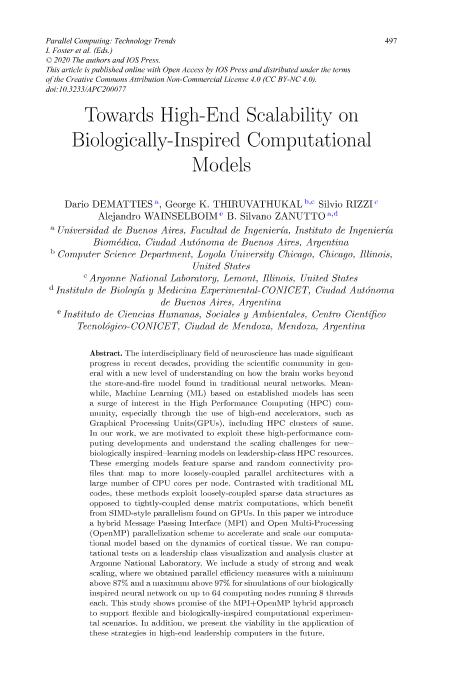Mostrar el registro sencillo del ítem
dc.contributor.author
Dematties, Dario Jesus

dc.contributor.author
Thiruvathukal, George K.
dc.contributor.author
Rizzi, Silvio

dc.contributor.author
Wainselboim, Alejandro Javier

dc.contributor.author
Zanutto, Bonifacio Silvano

dc.contributor.other
Foster, Ian

dc.contributor.other
Joubert, Gerhard R.
dc.contributor.other
Kučera, Luděk
dc.contributor.other
Nagel, Wolfgang E.
dc.contributor.other
Peters, Frans
dc.date.available
2021-05-06T01:07:43Z
dc.date.issued
2020
dc.identifier.citation
Dematties, Dario Jesus; Thiruvathukal, George K.; Rizzi, Silvio; Wainselboim, Alejandro Javier; Zanutto, Bonifacio Silvano; Towards high-end scalability on biologically-inspired computational models; IOS Press; 36; 2020; 497-506
dc.identifier.isbn
978-1-64368-071-2
dc.identifier.uri
http://hdl.handle.net/11336/131407
dc.description.abstract
The interdisciplinary field of neuroscience has made significant progress in recent decades, providing the scientific community in general with a new level of understanding on how the brain works beyond the store-and-fire model found in traditional neural networks. Meanwhile, Machine Learning (ML) based on established models has seen a surge of interest in the High Performance Computing (HPC) community, especially through the use of high-end accelerators, such as Graphical Processing Units(GPUs), including HPC clusters of same. In our work, we are motivated to exploit these high-performance computing developments and understand the scaling challenges for new–biologically inspired–learning models on leadership-class HPC resources. These emerging models feature sparse and random connectivity profiles that map to more loosely-coupled parallel architectures with a large number of CPU cores per node. Contrasted with traditional ML codes, these methods exploit loosely-coupled sparse data structures as opposed to tightly-coupled dense matrix computations, which benefit from SIMD-style parallelism found on GPUs. In this paper we introduce a hybrid Message Passing Interface (MPI) and Open Multi-Processing (OpenMP) parallelization scheme to accelerate and scale our computational model based on the dynamics of cortical tissue. We ran computational tests on a leadership class visualization and analysis cluster at Argonne National Laboratory. We include a study of strong and weak scaling, where we obtained parallel efficiency measures with a minimum above 87% and a maximum above 97% for simulations of our biologically inspired neural network on up to 64 computing nodes running 8 threads each. This study shows promise of the MPI+OpenMP hybrid approach to support flexible and biologically-inspired computational experimental scenarios. In addition, we present the viability in the application of these strategies in high-end leadership computers in the future.
dc.format
application/pdf
dc.language.iso
eng
dc.publisher
IOS Press

dc.rights
info:eu-repo/semantics/openAccess
dc.rights.uri
https://creativecommons.org/licenses/by-nc-sa/2.5/ar/
dc.subject
MPI
dc.subject
OPENMP
dc.subject
CENTRAL PROCESSING UNITS
dc.subject
BIOLOGICAL MODELS
dc.subject
NEUROSCIENCE
dc.subject
IRREGULAR COMPUTATION
dc.subject.classification
Otras Ingeniería Médica

dc.subject.classification
Ingeniería Médica

dc.subject.classification
INGENIERÍAS Y TECNOLOGÍAS

dc.title
Towards high-end scalability on biologically-inspired computational models
dc.type
info:eu-repo/semantics/publishedVersion
dc.type
info:eu-repo/semantics/bookPart
dc.type
info:ar-repo/semantics/parte de libro
dc.date.updated
2020-08-24T18:08:34Z
dc.journal.volume
36
dc.journal.pagination
497-506
dc.journal.pais
Estados Unidos

dc.journal.ciudad
Clifton
dc.description.fil
Fil: Dematties, Dario Jesus. Universidad de Buenos Aires. Facultad de Ingeniería. Instituto de Ingeniería Biomédica; Argentina
dc.description.fil
Fil: Thiruvathukal, George K.. University of Chicago; Estados Unidos
dc.description.fil
Fil: Rizzi, Silvio. Argonne National Laboratory; Estados Unidos
dc.description.fil
Fil: Wainselboim, Alejandro Javier. Consejo Nacional de Investigaciones Científicas y Técnicas. Centro Científico Tecnológico Conicet - Mendoza. Instituto de Ciencias Humanas, Sociales y Ambientales; Argentina
dc.description.fil
Fil: Zanutto, Bonifacio Silvano. Universidad de Buenos Aires. Facultad de Ingeniería. Instituto de Ingeniería Biomédica; Argentina. Consejo Nacional de Investigaciones Científicas y Técnicas. Instituto de Biología y Medicina Experimental. Fundación de Instituto de Biología y Medicina Experimental. Instituto de Biología y Medicina Experimental; Argentina
dc.relation.alternativeid
info:eu-repo/semantics/altIdentifier/url/http://ebooks.iospress.nl/volumearticle/53956
dc.relation.alternativeid
info:eu-repo/semantics/altIdentifier/doi/http://dx.doi.org/10.3233/APC200077
dc.conicet.paginas
804
dc.source.titulo
Parallel computing: technology trends
Archivos asociados
